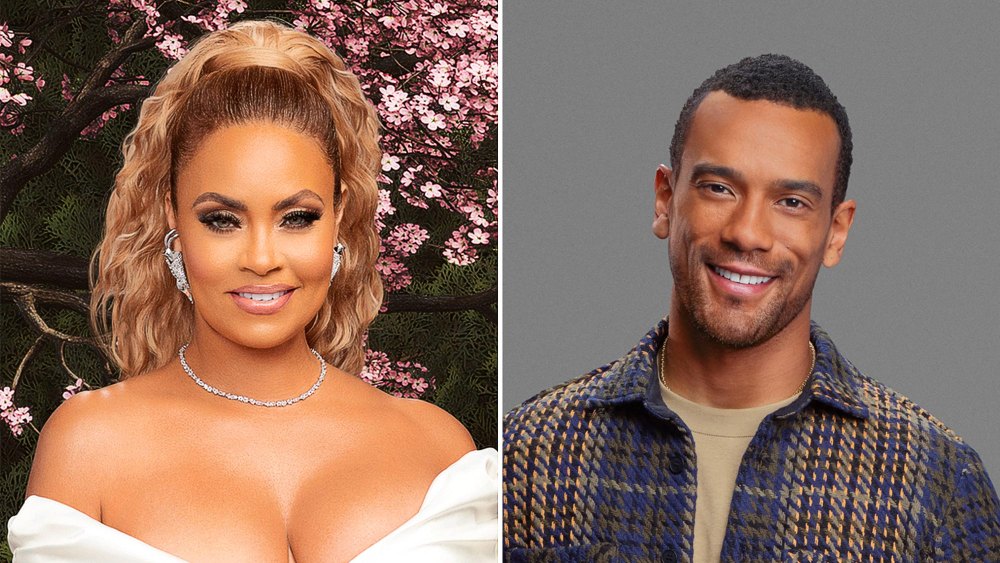Entertainment
RHOP’s Gizelle Bryant Is ‘Super Happy’ With Winter House’s Jason Cameron on November 1, 2023 at 2:00 am Us Weekly

The Real Housewives of Potomac star Gizelle Bryant gave Us some insight into her romance with fellow Bravo personality Jason Cameron.
“I’m super happy that Jason kind of understands me, gets my life. I clearly understand his life,” Bryant, 53, exclusively tells Us Weekly while discussing season 8 of RHOP. “He has been a breath of fresh air and someone that I can just tell everything to, and I know it stays with him.”
While Bryant shares that things have been going well between her and the Winter House alum, 37, over the past year, she explains that she doesn’t “feel the need” to put a title on their romance just yet.
“I just am appreciating the time that we have and the time that we spend together,” she clarifies to Us. “We have so much fun when we’re together, I’m just happy doing what we’re doing.”
Bryant adds that one of the reasons their relationship has been working is that they’re “not putting any pressure on it.”
Gizelle Bryant, Jason Cameron. Bravo (2)
“We’re not allowing other people to make us put pressure on it. And we’re there for each other,” she gushes. “And my dad passed recently. He understands [that]. His mother passed a while ago, and so he’s just been able to see me for who I am, and I appreciate that.”
Bryant, who shares daughter Grace, 18, and twins Adore and Angel, both 17, with ex-husband Jamal Bryant, adds that her daughters love Cameron — even if they were “unsure” at first.
“So when he came to see me one of the first times, they were like, ‘Well, we have questions,’” she explains. “And so they asked him a million questions and he passed the test.”
While Cameron will make some appearances on the next season of RHOP, Bryant has no interest in ever appearing on Winter House. (Cameron was a full-time cast member on seasons 1 and 2 of the Summer House spinoff and a “friend” for season 3, which is currently airing.)
“I don’t understand it. When he FaceTimed me, there was [Tom] Schwartz in the bed with potato chips everywhere, and it was just a little disgusting,” Bryant says. “It’s definitely not my scene, but it he invited me, I would go for him.”
Bryant was previously married to Jamal, 52, from 2002 to 2009. Although they rekindled things in 2019, they called it quits for good in June 2021.
“Listen, we were a victim of the pandemic,” she told E! News in July 2021. “I don’t think any long distance relationship can really withstand not seeing each other. But is he still in my life, is he still one of my best friends? Absolutely.”
Watch Real Housewives of Potomac season 8 on Bravo Sunday, November 5, at 8 p.m. ET.
The Real Housewives of Potomac star Gizelle Bryant gave Us some insight into her romance with fellow Bravo personality Jason Cameron. “I’m super happy that Jason kind of understands me, gets my life. I clearly understand his life,” Bryant, 53, exclusively tells Us Weekly while discussing season 8 of RHOP. “He has been a breath
Us Weekly Read More
Entertainment
What Film Producers Really Do

When the credits roll and audiences marvel at a spectacular film, few realize the incredible journey that brought that story to life. At the heart of this journey is the film producer – a professional who is part creative visionary, part business strategist, and entirely passionate about storytelling.

Film producers are essentially the architects of cinema, transforming a simple idea into a fully realized motion picture. Their work begins long before actors step in front of cameras, starting with discovering compelling stories and securing the rights to bring them to screen. Imagine a producer as a talent scout with an incredible eye for potential, constantly searching for narratives that could captivate global audiences.
The producer’s role is remarkably complex and multifaceted. They’re responsible for assembling the creative team, which means finding the perfect director, negotiating with screenwriters, and making critical casting decisions. But their job isn’t just about creative choices – they’re also financial strategists who must secure funding, manage budgets, and ensure the project remains economically viable.

During actual film production, producers become problem-solvers extraordinaire. They navigate countless challenges, from unexpected location issues to creative disagreements, always keeping the project moving forward. They’re the bridge between artistic vision and practical execution, making sure the director’s creative goals align with financial realities.
Post-production is another critical phase where producers shine. They oversee editing, potentially request additional scenes, and prepare the film for distribution. Their networking skills become crucial as they negotiate with studios, potential distributors, and international markets to ensure the film reaches its intended audience.
What makes a great producer isn’t just technical skill, but a unique blend of creativity, business acumen, and relentless passion. They must understand storytelling deeply while simultaneously managing complex logistical and financial challenges. It’s a role that requires intuition, strategic thinking, and an unwavering commitment to bringing remarkable stories to life.
While actors and directors often receive the spotlight, film producers are the true unsung heroes of cinema. They are the magical professionals who transform abstract ideas into the movies we love, cherish, and remember. Their work is a delicate dance of creativity, strategy, and pure cinematic magic.

Bolanle Media covers a wide range of topics, including film, technology, and culture. Our team creates easy-to-understand articles and news pieces that keep readers informed about the latest trends and events. If you’re looking for press coverage or want to share your story with a wider audience, we’d love to hear from you! Contact us today to discuss how we can help bring your news to life
Entertainment
The Rising Trend of Immigrant-Driven Police Car Destruction

Recent events have highlighted a concerning trend of police vehicle damage and theft during immigration-related protests. On February 3, 2025, a demonstration against federal immigration policies in Arizona’s West Valley turned violent, resulting in significant property damage and a brazen act of police vehicle theft.
Escalation of Protests
The protest, which began peacefully, escalated as the crowd grew to approximately 1,000 people. By 7:30 PM, demonstrators had taken over the intersection of 67th Avenue and Camelback Road, setting off fireworks and engaging in unruly behavior. As the situation deteriorated, some protesters began throwing rocks, concrete chunks, and glass bottles at officers.
Police Vehicle Theft and Damage
In a shocking turn of events, one protester managed to steal a police patrol vehicle. According to a Glendale Police spokesperson, the suspect “jumped into one of our patrol vehicles and drove it a short distance before it was quickly recovered”. This incident underscores the heightened tensions and bold actions taken by some demonstrators.
The damage was not limited to this single act of theft. Five marked patrol vehicles sustained significant damage, including:
- Broken windows
- Slashed tires
- Body and hood dents
Wider Impact and Response
The unrest spread beyond law enforcement targets. Multiple civilian vehicles and area businesses also suffered damage, and a large storage container behind a business complex was set on fire. To regain control of the situation, authorities deployed chemical agents around 10:15 PM to disperse what they termed an “unlawful assembly”.
Context of Immigration Tensions
This incident occurs against the backdrop of heightened immigration enforcement efforts by the Trump administration. Recent directives have led to an aggressive increase in arrests by U.S. Immigration and Customs Enforcement (ICE), with officials aiming to detain 1,200 to 1,500 individuals daily. This policy shift has sparked protests in multiple cities across the United States, including Los Angeles, Houston, and Atlanta.
Conclusion
The theft and destruction of police vehicles during immigration protests represent a troubling escalation in civil unrest. While the majority of demonstrators express their views peacefully, these incidents highlight the potential for violence and property damage when tensions run high. Law enforcement agencies and community leaders face the challenge of balancing public safety with the right to protest as the debate over immigration policies continues to intensify.
Bolanle Media covers a wide range of topics, including film, technology, and culture. Our team creates easy-to-understand articles and news pieces that keep readers informed about the latest trends and events. If you’re looking for press coverage or want to share your story with a wider audience, we’d love to hear from you! Contact us today to discuss how we can help bring your news to life
Entertainment
Beyoncé Rewrites Grammy History

Historic Achievements
- First Black woman to win Album of the Year in the 21st century
- First Black woman to win a country music award since the Pointer Sisters in 1974, winning Best Country Album for Cowboy Carter
Emotional Moment
During her Album of the Year acceptance speech, Beyoncé was initially frozen in place until her daughter Blue Ivy nudged her to approach the stage. She dedicated the award to Linda Martell, the pioneering Black country artist, saying, “I hope we keep pushing forward and opening doors.”
By the Numbers
- 35-time Grammy Award winner
- Nominated for 11 awards this year
- Won three awards total, tying with Charli XCX
Notable Quotes
“I just feel very full and very honored. It’s been many, many years,” Beyoncé said, thanking the Grammys, songwriters, collaborators, and producers. She also specifically acknowledged the Los Angeles firefighters who were present at the ceremony.
The win was particularly emotional, with fellow artists like Lady Gaga and Billie Eilish visibly moved by her historic achievement.

Bolanle Media covers a wide range of topics, including film, technology, and culture. Our team creates easy-to-understand articles and news pieces that keep readers informed about the latest trends and events. If you’re looking for press coverage or want to share your story with a wider audience, we’d love to hear from you! Contact us today to discuss how we can help bring your news to life

 Entertainment4 weeks ago
Entertainment4 weeks agoWhy Men Should Run To See “Love Brought Me Back

 Entertainment4 weeks ago
Entertainment4 weeks agoWhy Women Are Choosing Not to Have Children?

 Entertainment4 weeks ago
Entertainment4 weeks agoDid Ryan Reynolds Mock Justin Baldoni in Deadpool & Wolverine?

 Tech4 weeks ago
Tech4 weeks agoMark Zuckerberg Says Meta Will Allow More Free Speech

 News4 weeks ago
News4 weeks agoTop 5 Immediate Lifeline Resources for Fire Victims

 Entertainment4 weeks ago
Entertainment4 weeks agoJay-Z Sued Over Alleged Bribery Scheme

 News4 weeks ago
News4 weeks agoBogalusa Mayor Arrested for Prostitution and Drugs

 Politics4 weeks ago
Politics4 weeks agoJustin Trudeau Announces Resignation as Prime Minister



























